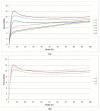Properties and Skin Compatibility of Films Based on Poly(Lactic Acid) (PLA) Bionanocomposites Incorporating Chitin Nanofibrils (CN)
- PMID: 32244595
- PMCID: PMC7353621
- DOI: 10.3390/jfb11020021
Properties and Skin Compatibility of Films Based on Poly(Lactic Acid) (PLA) Bionanocomposites Incorporating Chitin Nanofibrils (CN)
Abstract
Nanobiocomposites suitable for preparing skin compatible films by flat die extrusion were prepared by using plasticized poly(lactic acid) (PLA), poly(butylene succinate-co-adipate) (PBSA), and Chitin nanofibrils as functional filler. Chitin nanofibrils (CNs) were dispersed in the blends thanks to the preparation of pre-nanocomposites containing poly(ethylene glycol). Thanks to the use of a melt strength enhancer (Plastistrength) and calcium carbonate, the processability and thermal properties of bionanocomposites films containing CNs could be tuned in a wide range. Moreover, the resultant films were flexible and highly resistant. The addition of CNs in the presence of starch proved not advantageous because of an extensive chain scission resulting in low values of melt viscosity. The films containing CNs or CNs and calcium carbonate resulted biocompatible and enabled the production of cells defensins, acting as indirect anti-microbial. Nevertheless, tests made with Staphylococcus aureus and Enterobacter spp. (Gram positive and negative respectively) by the qualitative agar diffusion test did not show any direct anti-microbial activity of the films. The results are explained considering the morphology of the film and the different mechanisms of direct and indirect anti-microbial action generated by the nanobiocomposite based films.
Keywords: anti-microbial; chitin nanofibrils; poly(butylene succinate); poly(lactic acid); skin compatibility; starch.
Conflict of interest statement
The authors declare no conflict of interest.
Figures









Similar articles
-
Sustainable Micro and Nano Additives for Controlling the Migration of a Biobased Plasticizer from PLA-Based Flexible Films.Polymers (Basel). 2020 Jun 17;12(6):1366. doi: 10.3390/polym12061366. Polymers (Basel). 2020. PMID: 32560520 Free PMC article.
-
Flat Die Extruded Biocompatible Poly(Lactic Acid) (PLA)/Poly(Butylene Succinate) (PBS) Based Films.Polymers (Basel). 2019 Nov 11;11(11):1857. doi: 10.3390/polym11111857. Polymers (Basel). 2019. PMID: 31717937 Free PMC article.
-
Skin-Compatible Biobased Beauty Masks Prepared by Extrusion.J Funct Biomater. 2020 Apr 6;11(2):23. doi: 10.3390/jfb11020023. J Funct Biomater. 2020. PMID: 32268483 Free PMC article.
-
Chitin Nanofibrils in Poly(Lactic Acid) (PLA) Nanocomposites: Dispersion and Thermo-Mechanical Properties.Int J Mol Sci. 2019 Jan 24;20(3):504. doi: 10.3390/ijms20030504. Int J Mol Sci. 2019. PMID: 30682847 Free PMC article.
-
Super tough poly(lactic acid) blends: a comprehensive review.RSC Adv. 2020 Apr 1;10(22):13316-13368. doi: 10.1039/d0ra01801e. eCollection 2020 Mar 30. RSC Adv. 2020. PMID: 35492128 Free PMC article. Review.
Cited by
-
Electrosprayed Shrimp and Mushroom Nanochitins on Cellulose Tissue for Skin Contact Application.Molecules. 2021 Jul 20;26(14):4374. doi: 10.3390/molecules26144374. Molecules. 2021. PMID: 34299649 Free PMC article.
-
In vitro protective effects of Paeonia mascula subsp. hellenica callus extract on human keratinocytes.Sci Rep. 2020 Nov 5;10(1):19213. doi: 10.1038/s41598-020-76169-0. Sci Rep. 2020. PMID: 33154501 Free PMC article.
-
Liquid and Solid Functional Bio-Based Coatings.Polymers (Basel). 2021 Oct 22;13(21):3640. doi: 10.3390/polym13213640. Polymers (Basel). 2021. PMID: 34771197 Free PMC article. Review.
-
Biodegradable Polymeric Micro/Nano-Structures with Intrinsic Antifouling/Antimicrobial Properties: Relevance in Damaged Skin and Other Biomedical Applications.J Funct Biomater. 2020 Aug 19;11(3):60. doi: 10.3390/jfb11030060. J Funct Biomater. 2020. PMID: 32825113 Free PMC article. Review.
-
Bio-Based Packaging: Materials, Modifications, Industrial Applications and Sustainability.Polymers (Basel). 2020 Jul 14;12(7):1558. doi: 10.3390/polym12071558. Polymers (Basel). 2020. PMID: 32674366 Free PMC article. Review.
References
-
- Sharma R., Jafari S.M., Sharma S. Antimicrobial bio-nanocomposites and their potential applications in food packaging. Food Control. 2020;112:107086. doi: 10.1016/j.foodcont.2020.107086. - DOI
-
- Febo P., Gagliardini A. Baby Diapers Past and Present: A Critical Review. In: Morganti P., editor. Bionanotechnology to Save the Environment: Plant and Fishery’s Biomass as Alternative to Petrol. MDPI; Basel, Switzerland: 2018. pp. 227–238.
Grants and funding
LinkOut - more resources
Full Text Sources
Miscellaneous

